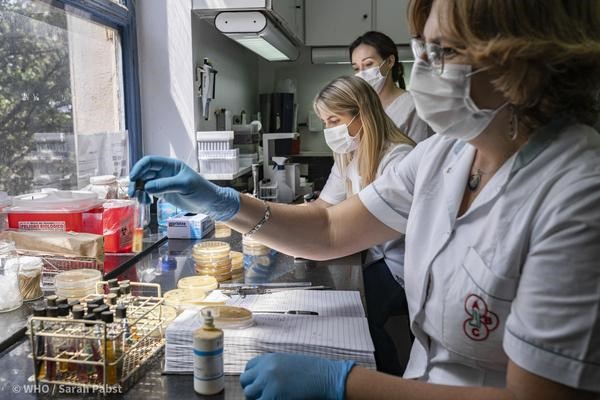Description

Source: CIDRAP
Disclaimer: Copyright infringement not intended.
Context
- The World Health Organization (WHO) has updated its Bacterial Pathogens Priority List (BPPL) for the first time since 2017.
- This list is crucial for guiding research and development (R&D) efforts, antimicrobial resistance (AMR) surveillance, and infection prevention strategies.
Details
Categories and Criteria
- The updated BPPL categorizes 24 pathogens and 15 "drug-bug" combinations into critical, high, and medium priority groups. These categories are based on eight criteria:
- Mortality
- Incidence
- Non-fatal health burden
- Trend of resistance
- Transmissibility
- Preventability in healthcare and community settings
- Treatability
- Number of antibiotics in the pipeline
Critical Priority Pathogens
Characteristics
- High Threat:Limited treatment options, high morbidity and mortality, and ability to share resistance mechanisms.
- Focus:Primarily gram-negative bacterial pathogens found in hospitals.
Key Pathogens
- Gram-Negative Bacteria:
- Resistant to carbapenems and third-generation cephalosporins.
- Examples: Acinetobacter baumannii, Pseudomonas aeruginosa, Enterobacteriaceae(including Klebsiella pneumoniae, Escherichia coli).
- Third-Generation Cephalosporin-Resistant Enterobacterales (3GCRE): Notable for high rates of treatment failure, especially in neonatal sepsis.
- Mycobacterium tuberculosis:
- Resistant to Rifampicin, a key antibiotic for tuberculosis treatment.
- Rifampicin-Resistant Tuberculosis (RR-TB): Newly added due to diagnostic and treatment challenges.

High Priority Pathogens
Characteristics
- Substantial Burden:Difficult to treat, cause significant disease burden, particularly in low- and middle-income countries, and increasing resistance.
- Community Pathogens:More emphasis on pathogens causing community-acquired infections.
- Healthcare Challenges:Pose major issues in hospital and healthcare settings.
Key Pathogens
- Methicillin-Resistant Staphylococcus aureus (MRSA)
- Vancomycin-Resistant Enterococcus faecium
- Fluoroquinolone-Resistant Shigella: Moved from medium to high priority due to increasing resistance.
- Fluoroquinolone-Resistant Salmonella Typhi: Leading cause of typhoid fever with significant global health impact.
- Fluoroquinolone-Resistant Non-Typhoidal Salmonella: Leading cause of foodborne illness with growing resistance concerns.
- Third-Generation Cephalosporin-Resistant and/or Fluoroquinolone-Resistant Neisseria gonorrheae
- Pseudomonas aeruginosa:Also listed under critical for some strains.
Medium Priority Pathogens
Characteristics
- Increasing Resistance:Pose significant challenges in vulnerable populations and low- and middle-income countries (LMICs).
Key Pathogens
- Macrolide-Resistant Group A Streptococci
- Penicillin-Resistant Group B Streptococci
- Macrolide-Resistant Streptococcus pneumoniae
- Ampicillin-Resistant Haemophilus influenzae
- Neisseria gonorrhoeae
Notable Changes and New Additions
New Additions
- Macrolide-Resistant Group A Streptococci
- Penicillin-Resistant Group B Streptococci
- Macrolide-Resistant Streptococcus pneumoniae
Notable Removals
- Clarithromycin-Resistant Helicobacter pylori
- Fluoroquinolone-Resistant Campylobacter spp
- Penicillin-Non-Susceptible Streptococcus pneumoniae
- Third-Generation Cephalosporin-Resistant Providencia spp
- Vancomycin-Intermediate and -Resistant Staphylococcus aureus
Implications
Public Health and R&D
- Community Pathogens:Increased recognition of community-acquired pathogens highlights the need for public health and R&D focus.
- Global Health Burden:Emphasizes the need for ongoing surveillance, research, and targeted interventions, especially in LMICs.
Investment and Strategy
- Guiding Investment:The updated list aims to direct investments towards the most pressing threats and critical needs in antibiotic development.
- Infection Control:Enhanced focus on preventing the spread of resistant pathogens in healthcare and community settings.
WHO Recommendations
- Research and Development:
- Invest in the development of new antibiotics, diagnostics, and vaccines.
- Promote alternative treatments and prevention strategies.
- Surveillance and Monitoring:
- Strengthen global surveillance systems to track resistance patterns and emerging threats.
- Enhance data sharing and collaboration among countries.
- Antimicrobial Stewardship:
- Implement robust antimicrobial stewardship programs to optimize the use of existing antibiotics.
- Educate healthcare providers and the public on the appropriate use of antimicrobials.
- Infection Prevention and Control:
- Improve infection control measures in healthcare facilities.
- Promote hygiene and sanitation practices in communities.
Sources:
CIDRAP
|
PRACTICE QUESTION
Q. The updated Bacterial Pathogens Priority List by the WHO underscores the urgent need for global action to combat antibiotic resistance. Comment. (150 Words)
|











